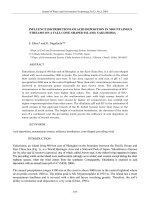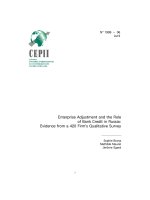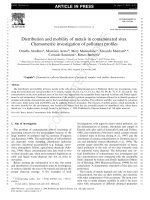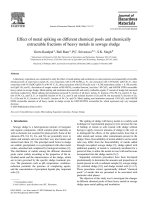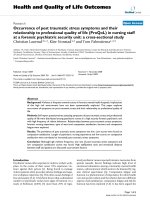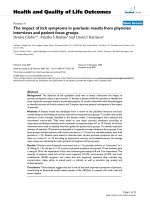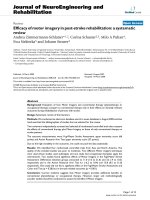Immobilization of heavy metals in sediment dredged from a seaport by iron bearing materials
Bạn đang xem bản rút gọn của tài liệu. Xem và tải ngay bản đầy đủ của tài liệu tại đây (879.75 KB, 10 trang )
H a n o i O c t o b e r 2 0 1 0
Group assignment
Solutions for medical wastes in Vietnam
Nguyen Thi Quynh Mai – 0851050049
Phạm Thanh Hải - 0851050064
P u b l i c e c o n o m i c s – L e c t u r e r : L y H o a n g P h u , M s c
Group assignment Solutions for medical wastes in Vietnam
Public economics
Table of Contents
What is medical waste ........................................................................... 2
Definition of medical wastes ................................................................ 2
Definition according to Wikipedia ..................................................... 2
Definition according to Ministry of Public Health of Vietnam ........... 2
Classification of medical wastes ........................................................... 2
Situation of medical wastes in Vietnam ................................................ 3
From solid wastes ................................................................................. 3
To liquid wastes .................................................................................... 4
Financial difficulties .............................................................................. 5
Solution of medical wastes in Vietnam.................................................. 6
Solutions for solid medical wastes ....................................................... 6
Solutions for liquid medical wastes ...................................................... 7
Solution for financial difficulties ........................................................... 8
Conclusion .............................................................................................. 8
Resources ............................................................................................... 9
Group assignment Solutions for medical wastes in Vietnam
Public economics
Solutions for medical wastes in Vietnam
1. What is medical waste?
1.1. Definition of medical wastes
1.1.1 Definition according to Wikipedia
Medical, known as clinical waste, normally refers to waste product that cannot be
considered as general waste, produced from healthcare premises, such as
hospital, clinics, doctors’ offices, labs and nursing homes.
Medical waste is solid and liquid waste created by diagnosing, treating or
immunizing people or animals. It can also be the product of the research and
testing of biological products.
1.1.2. Definition according to the Ministry of Public Health of Vietnam
Medical wastes are material in form of solid, liquid or gases which are eliminated
from healthcare premises. Medical wastes include injurious medical wastes and
common wastes.
Injurious medical wastes are medical wastes which contain factors that can harm
man’s health and environment. Those factors should be easy-infectious,
radioactive, inflammable, etc.
1.2. Classification of medical wastes
1.2.2. Infectious waste
Infectious wastes can cause harm to people or the environment, and this category
includes items such as bandages, surgical gloves, surgical instruments, needles and
microbial dishes, cultures and cloths.
Sharp waste
Unsharp wastes
Group assignment Solutions for medical wastes in Vietnam
Public economics
Extremely infectious wastes
Surgical wastes
1.2.1. Hazardous chemical wastes
Expired medicine, low quality medicine
Harmful chemical factor in healthcare
Wastes harm cell
Wastes contain heavy metal
1.2.2. Radioactive wastes
1.2.3. Vessel contains pressure
1.2.4. General wastes
Life wastes
Wastes from medical activities do not contain blood, biological juice, etc.
Wastes from administrative activities
Surrounding wastes
2. Situation of medical wastes in Vietnam
2.2. From solid wastes…
According to the report of Ministry of public health, up to 2005, there were about 1047
hospitals with 140,000 sick-beds and 10,000 medical stations. Out of 2.5 kg wastes
eliminated from each sick-bed per day, 10-15% is harmful wastes, which include dressing of
wounds, syringes, sharp matters, medicines, radioactive and parts of body removed after
surgeries.
Also from the Ministry of public health, 2/3 of all hospitals have not applied safety waste
disposal methods. Most wastes have not been classified and disinfected before discharging.
Store houses are non-standard, unsanitary and highly infectious. In some areas, medical
wastes are urgent matters because there have been no places for wastes to be gathered
even in provincial hospital level.
Recent statistics show that in Thaibinh province, there were about 2,000 sick-beds which
eliminated 1,000-3500 kg wastes per day. Out of them, 20% were harmful wastes. Most
hospitals have used method of burring wastes in the precincts except hospitals which has
Group assignment Solutions for medical wastes in Vietnam
Public economics
had manual incinerator. In other hospitals, the manual incinerator is burned and leaves an
uncomfortable smell
According to the “Regulation of medical waste management” of the Ministry of Public Health,
medical waste must be treated immediately at once, contained in bag or barrel according to
color and standard. In fact, in most hospitals, especially in private medical stations, they do
not follow the regulations. There have been many sanitation workers dumping waste bags to
roadsides.
In particular, Hanoi has thousands of medical stations, making up about 2% of total wastes.
Only 60 hospitals and medical centers have signed up for waste treatment contract with
Hard Medical Waste Enterprise with the amount of 1.5 tons per day. The rest of these
wastes, for some reasons, are still mixed with household waste and increased rapidly. More
than 310 private medical stations have not taken responsibility for their wastes or followed
the regulations. They quibble that the amount of waste eliminated was too low or they did
not know where to dispose it.
One of the most dangerous problems is that tons of medicine covers, plastic infusion tubes,
cylinder, etc. instead of being processed from many hospitals in Hanoi, especially Viet-Duc
hospital, have been sold to scrap purchasers. On the 10
th
of August, when inspecting a truck
which was going to the scrap purchased place in Hanoi, the Department of Natural
Resources and Environment protection detected 60 bags of medical wastes which weighed
about 700 kg. These bags contained medicine covers, plastic infusion tubes and cylinders.
This truck started from Viet-Duc hospital. At the same time, they also detected a truck which
contained 16 bags of medical wastes (300 kg) running from Viet-Duc hospital to Hoan Kiem
district. The truck drivers declared that they bought wastes from Viet-Duc hospital at the
price of 6,000 VND per kilogram for plastic, 1,500 VND per kilogram for small glass bottle.
From 2002 to 2007, there were about 300 tons of medical wastes sold from Vietduc hospital
to scrap purchasers and all of them were sold to manufacture appliances.
2.3. To liquid wastes
Liquid wastes should be ranked the first in term of toxicity
because of huge amount of germs
and bacteria. Most hospitals have only focused on processing hard waste by incinerator

